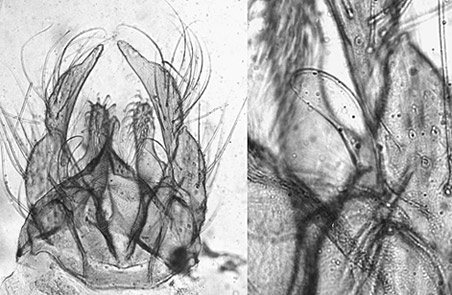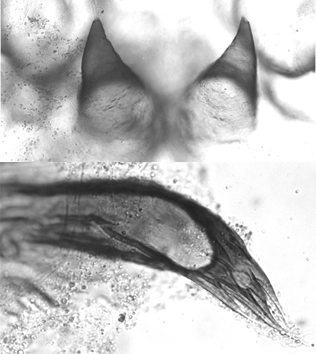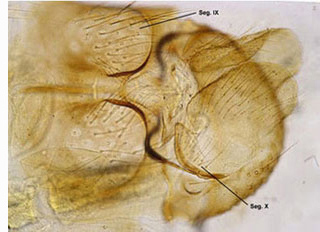Species r. C. 'tigris' Butler and KiknadzeNow a nomen nudum as the name was published by Martin et al. (2008) and Kiknadze et al. (2016). C. sp. Am1 - Kiknadze et al. 1993. C. species r - Butler et al. 1995.This species is a member of the staegeri group erected by Wülker et al. (1971) In BOLD Bin no. BOLD3004. Adult: Male: About 3 setae near middle of 9th tergite, gonostyle tapering over posterior third, and superior volsella closest to D(e)-type of Strenzke (1959); Inferior volsella reaching beyond the end of the anal point to about mid-point of the gonostylus.  Male hypopygium (left) and superior volsella (right) of C. ‘tigris’. Wing length abt 5.57 mm, width abt 1.39-1.40 mm, VR abt 0.99, 3-4 SCf on brachiolum; abt 36-53 setae in the squamal fringe. Antennal segments (µm): 220 (29%) ; 150 (52%) : 140 (50%) : 166 (53%) : 268. AR – 0.38; A5/A1 – 1.20. Frontal tubercles moderately developed, about 2.2-2.3 times longer than wide (33-46 x 15-20 µm).Clypeal width about 2.2 times diameter of antennal pedicel with about 50-67 setae. Palpal segments (µm) 98 : 69 : 267 : 284; 405; P5/P4 1.47. Thoracic setae: Acrostichal - abt. 19-24; Humeral - 5-7 in an anterior group, then 3-8 roughly linear; Dorsocentral - 33-38; Prealar - 8-9; Supraalar - 1-2; Scutellars in 2 to 3 approximate rows of 6-18 (5 & 13) and posterior row of 11-18 setae. Leg lengths (µm) and proportions:
Pupa caudolateral spur of segment VIII with about 5 or 6 spines.  Pupa of C. ‘tigris’ Cephalic tubules (above), spur (below) Larva a large plumosus-type (length, female: 17.6 - 20.4 mm) with anterior ventral tubule longer (female: Ant. 1.5 - 2.4 mm; post. 1.3 - 2.1 mm). Gular region completely darkened (see Proulx et al. 2013) and frontoclypeus darkened. The larva can be most easily separated from the other members of the staegeri group by the smooth anterior margin of the ventromentum and by the lower number of striae 34-46 cf. 60-80, and the shorter PLT. The FA is also generally darker. The relatively shallow curve and sharp teeth of the mentum will also help to distinguish it from many species. Cytology: 2 long polytene chromosomes, banding pattern often unclear. Arm combination GAB, FEDC. tigA1: 1 - 2c, 10 - 12, 3 - 2d, 9 - 4, 13 - 19 as holA1 and staA1 Molecular data. There is mtCOI sequence in GenBank (KF278239-53), as well as specimens in BOLD, as Chironomus sp. Also sequence for gb2β. Found: Ontario - Clarke Lake (45.53°N, -78.27°W), Algonquin Provincial Park In thick mud at depths around 6 m in lakes. Proulx et al. (2013) give some key features of the larval morphology, notes on the cytology and relationships of the mtCOI to that of other species. Cytology is also mentioned in Martin et al. (1974) and Martin (1979), described by Kiknadze et al. (1993) as C. sp. Am1), and by Kiknadze et al. (2016) as C. tigris, attributed to Butler & Kiknadze 2003 (which is only an abstract and so has no valid status). |
Modified: 29 April 2025
Access: Unrestricted
Copyright © 2000-2022, Jon Martin.
